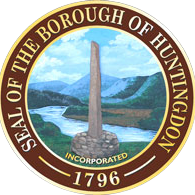Brief History of Portstown Park:
Portstown was a retangular piece of ground originally located between the Pennsylvania Canal, Juniata River and the Huntingdon and Indiana Turnpike. — Now route 26, the road to Bedford and Williamsburg.
1. The original ground was owned by William Smith, founder of Huntingdon. 1767.
2. Ground on which Portstown was laid out, passed through the Smith Family and was sold at the “High Sheriff’s” sale in 1825 to John Port. Port bought about three acres for $41.00 ( in 1828 dollars.)
3. Muddy Run in 1820’s was known as Clay Lick.
4. In 1828 the Commonwealth of Pennsylvania began an ambitious project to construct a canal across Pennsylvania, following the Juniata River, and through Huntingdon.
5. Port intended to lay out a small town known as Freeport.
6. First parcel or building lot was sold to John White in 1827 for $ 50.00.
7. John Port died in 1829.
8. After Port’s death, John White and the sons of John Port — Alexander and James — carried out John Port’s dream of building a village, but renamed it Portstown circa 1830.
9. Deeds from 1840 to the removal of Portstown in the 1970’s — through a project known as Urban Renewal — carried the name Portstown.
10. At one time within the geographic boundaries of Portstown had 32 structures.
11. In 1837, the first bridge linking Huntingdon to Smithfield Township was built by the Juniata Bride Company. It was built at the location of a wagon fording across the Juniata River. A Toll House was built to collect fees from those using the bridge crossing the Juniata and traveling to Portstown and Huntingdon.
12. By 1970 Portstown was comprised of three sections of land from the original land owned by William Smith, and sold to the Port family. Portstown Park is located in a section of land owned by the Port family, in part or in whole, from 1827 to 1880 with various sections being sold as the community developed.
13. Significant building once in Portstown.
a. Toll Bridge and House. 1837 to circa 1854.
b. Blacksmith Shop and Foundry of Samuel Davis (1827 – 1834)
c. Warehouse and store ( on the canal bank) owned by Mr. White and Cornprobst circa 1850’s
d. Grist Mill of Isenburg and later Henry and Company (Laney’s) circa 1881.
e. Pennsylvania Canal 1830 to 1888.
f. Portstown Arch, built by the Pennsylvania Railroad in the early 1900’s, after the railroad tracks and railroad alignment was moved from running down the middle of Allegheny Street.
g. Huntingdon and Broad Top Railroad Trussel, circa 1850’s.
14. Portstown was home to railroad workers, business men, canal workers and their families..
Compiled by: George John Drobnock, May 2004

